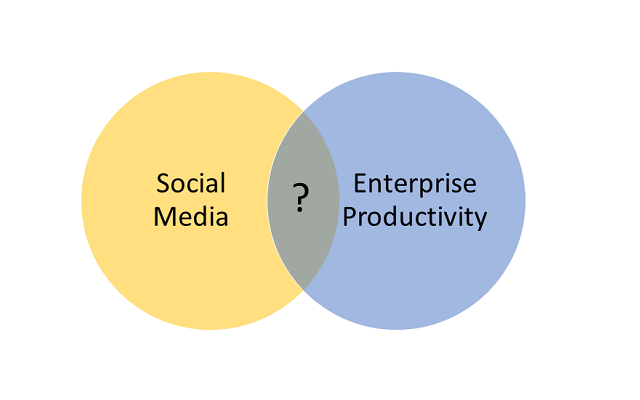Enterprise Social Media is the way forward! It’s the dawn of a new era in collaboration. It will kill email and make us all happier and more productive employees in flatter more agile organisations.
Well, at least that was what we were all saying a few years back. Even as long ago as 2006, when ‘Enterprise 2.0’ was first coined to take advantage of the power of user generated content inside organisations, we’ve all eyed the potential of turning those exciting products we use in our personal lives, into the next big thing in business.
But almost 12 years have passed since then, and we’re already 6 years on since Microsoft made that purchase, yet we haven’t killed email, we haven’t fundamentally changed the way we work and we haven’t seen the proven results we’d expected. Stories of failed implementations of social tools are rife and backed up by Gartner’s often quoted “80% will fail in 2015” report, but not many agree on why. Since leaving the Government after playing with a number of social platforms and joining a company doing it differently, I thought I’d share what I’ve discovered so far on the likely causes of failure of Enterprise Social projects:
1. Not defining success. I was at a “social media gurus” event a little while back and was surprised to find some people still defining success in terms of adoption, or number of shares or even worse, ‘likes’. If you can’t define success by making the link between the use of the social platform and your organisation’s top-level objectives, how can you ever be ‘successful’? Increased sales, retention, reduced spend on consultants, whatever it is you’re trying to achieve, be clear and benchmark before and routinely thereafter.
2. Cats (and other things non-work related). Your boss probably uses social in their spare time and they probably see that social content is seemingly 90% cat-related. So when you say to your boss “hey, we’d like to use a social platform to engage our staff and allow them to [collaborate/connect/insert value proposition here]” I suspect all they hear is “cats, cats, cats, cats”. Even if they believe in it, they have to answer to the board/shareholders/public or someone else who cares a lot more about work getting done than the ability of your staff to tell their colleagues what they had for lunch. I’m not suggesting they do that but convincing the board they can’t/don’t is the key challenge with a ‘social’ platform.
3. Senior support. Possibly due to points 1 & 2 senior staff and leadership support for the use of a social platform in the business might be difficult to achieve. But in addition it’s sometimes a generational thing. People who haven’t grown up using social can sometimes still be daunted by who’s going to see what they write and what if they make a mistake etc. Valid concerns backed up by the horror stories we’ve seen when it goes wrong. Senior leaders are especially sensitive to this and ask all the time for the ability to share information, but only with the right people. But social, by its nature, is often open to all meaning everyone (to a degree) then has to self-sensor their content to ensure it’s not going to be mis-understood or mis-interpreted by others.
4. Training. Social platforms may be simple. It may be quite easy to work out what button does what when you click it. But knowing when to click it and why still requires training. When I’m running sessions the majority of the time I focus on the value for the individual and the case for collaboration for the organisation (the Why) because if you give them a good enough why, they’ll work out the how for themselves. But knowing the why comes back to the initial business case and being clear on what value are you trying to achieve through what improved processes? It’s OK to add to the list of value propositions as you go, but the ‘organic’ approach to just throwing it out there and seeing where it lands is a recipe for lengthy sub-par results.
5. Noise. Unfortunately, most social platforms just add to the information overload already experienced by many employees because their fundamental mechanics are the same as the social platforms we use in our personal lives. Join the right groups and follow the right people and if you’re there at the right time you’ll see useful information. But which groups? And which colleagues? And when? You might follow a colleague because they’re relevant to you today, but that doesn’t mean they will be relevant to you tomorrow. But tomorrow, and every day after that, you’re still going to get their status updates in you feed and potentially miss the relevant ones. Social platforms aren’t designed to really help you with the key challenge which is who should you be connecting with now in the context of the challenge you’re facing now?
6. Re-enforcing silos. If you’ve delegated the ability for individual users or teams to create groups, networks or forums, what’s the first thing they do? They create an online group that replicates their offline hierarchy. Great! Only that doesn’t really add much value over their existing email dist lists and sharepoint sites and in fact can cause duplication and other knowledge management nasties. In addition, too many eager users creating groups with too few members leads to a confusing experience that can put off new users when they’re trying to find the active and valuable groups.
7. Management overhead. If you haven’t delegated the ability to create groups then you’ve got yourself a huge task of mapping the structures and communities of interest to enable the sharing of information across boundaries. Unfortunately these structures change as often the organisation and finding and managing champions to promote the use of these groups across different hierarchies is difficult to do and requires constant management. Due to points 1, 2 and 3 (amongst others) senior leaders may not be engaged enough to support their staff taking time to manage groups and drive adoption when the benefits are seemingly spread across other parts of the business.
One reason I didn’t add to this list is the ‘everyone else is doing it so we should to’ mentality. I didn’t add it because even though it’s rife, it’s not a reason for failure. It’s a reason not to start at all. There are alternatives to increasing productivity and engagement with your workforce without relying on social mechanics. That will be my next post!
Article by channel:
Everything you need to know about Digital Transformation
The best articles, news and events direct to your inbox
Read more articles tagged: Featured, Social Media






